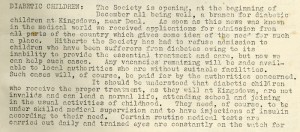It was in 1948 that The Children’s Society started to look after children with diabetes. Before that date, without any specialist staff or equipment, The Children’s Society simply hadn’t been able to take any diabetic children into its homes.
Everything changed in 1948 when St Monica’s Home for Diabetic Children, Kingsdown, near Deal in Kent, opened. The home had trained staff who were able to give the children the medical care they needed and teach them how to administer their own insulin.
Below is an extract from The Children’s Society’s Bulletins in October 1948, giving more information about the imminent opening of St Monica’s Home.
On reading the extract it appears that there was a high demand for children’s homes that could care for children with diabetes. One of the reasons for opening the home was to reduce the number of fatalities that came from diabetic children not having access to the medical care they needed.
Demand for children’s homes for diabetic children was so high that The Children’s Society opened two others shortly afterwards: St George’s Home in Kersal, Manchester, was converted into a home for diabetic children in 1949 and Carruthers Corfield House Home for Diabetic Children in Rustington, Sussex, opened in 1951.
The Bulletins that the above extract came from were regular newsletters created by The Children’s Society’s head office and sent out to its children’s homes. These Bulletins contained important news about the work of The Children’s Society and included information and policies about how the children’s homes should be run.
Some of the Bulletins include medical information, such as the necessity of providing children with certain vaccinations, procedures to be carried out during outbreaks of diseases in the homes, and guidance on the diets to be given to the children. This makes the Bulletins a useful resource for studying The Children’s Society’s policies on various medical issues.


